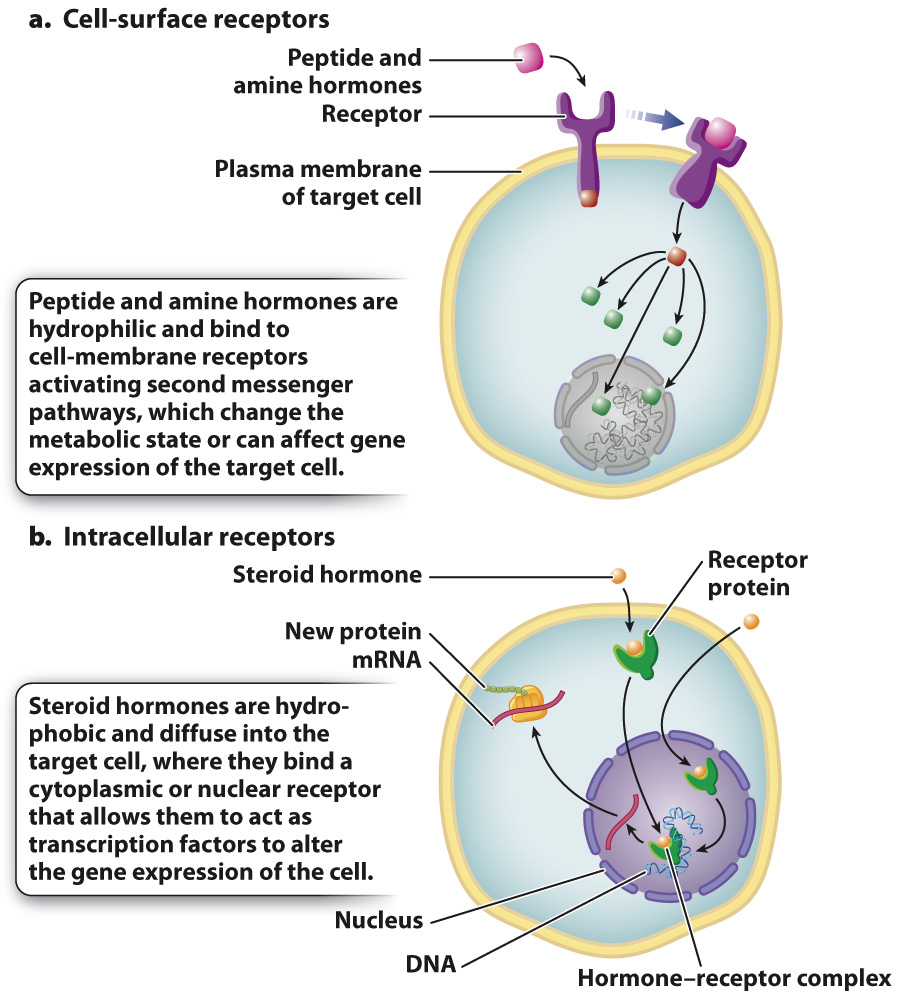Two main classes of hormone are peptide and amines, and steroid hormones.
Some hormone receptors are located on the cell surface, others are located inside the cell. Where a receptor is located depends on characteristics of the hormone molecules themselves. Hormones can be grouped into two general classes: hydrophilic molecules, which cannot diffuse across the plasma membrane, and hydrophobic molecules, which can. The hydrophilic hormones are peptide hormones and amine hormones, and the hydrophobic hormones are steroid hormones, examples of which are illustrated in Fig. 38.7.

Peptide hormones and amine hormones are both derived from amino acids (Figs. 38.7a and 38.7b). Peptide hormones are short chains of amino acids, whereas amine hormones are derived from a single aromatic amino acid, such as tyrosine or phenylalanine (Chapter 4). All steroid hormones are derived from cholesterol (Fig. 38.7c). Whereas peptide hormones (which are sometimes large enough to be considered proteins) can evolve through changes in their amino acid sequence, steroid hormones cannot. Evolutionary changes in steroid hormone function depend instead on changes in their synthetic enzymes or changes in the receptors they bind and the cellular responses they trigger.
Peptide and amine hormones are more abundant than steroid hormones and are more diverse in their actions. Because most peptide and amine hormones are hydrophilic and cannot diffuse across the plasma membrane (exceptions are thyroid hormones), nearly all these hormones bind to membrane receptors on the surface of the cell (Fig. 38.8a). Peptide and amine hormones alter the biochemical activity of the target by initiating signaling cascades within the target cell, as discussed in Chapter 9: The bound receptor activates an enzyme or other molecule within the cell, and it in turn activates another and so on. Typically, the activated enzymes are protein kinases, which phosphorylate other proteins. These signaling cascades can lead to changes in gene expression or they can alter metabolism by turning on or off metabolic enzymes. For example, a peptide or amine hormone could trigger a cell to grow, divide, change shape, or to release another hormone. Peptide and amine hormones act on timescales of minutes to hours.

There are many examples of peptide hormones. In vertebrates, for instance, growth hormone stimulates protein synthesis and the growth of many body tissues, particularly the musculoskeletal system (Table 38.2). As we saw, insulin and glucagon are peptide hormones released by the pancreas that regulate glucose metabolism by the liver, muscles, and other tissues. Gastrin and cholecystokinin are peptide hormones that regulate mammalian digestive function (Chapter 40). In addition to serving as a neurotransmitter released by the sympathetic nervous system (Chapter 35), epinephrine and norepinephrine (also known as adrenaline and noradrenaline) are amine hormones, supporting an animal’s fight-

Because steroid hormones are hydrophobic, they diffuse freely across the cell membrane to bind with receptors in the cytoplasm or nucleus, forming a steroid hormone–
The sex hormones estrogen, progesterone, and testosterone (Table 38.2) are steroid hormones that regulate the development of the vertebrate reproductive organs. Cortisol is a steroid hormone that regulates a vertebrate animal’s response to stress and inhibits inflammation. Steroid hormones similar to cortisol are used medically to reduce the symptoms of certain inflammatory disorders. However, they carry risks because they also suppress the immune system, increasing the chance of infection and diminishing wound healing.
Quick Check 3 Why do peptide and steroid hormones bind different kinds of receptor, and how does this difference affect the resulting signaling pathways in the target cell?
Quick Check 3 Answer
Peptide hormones bind cell-